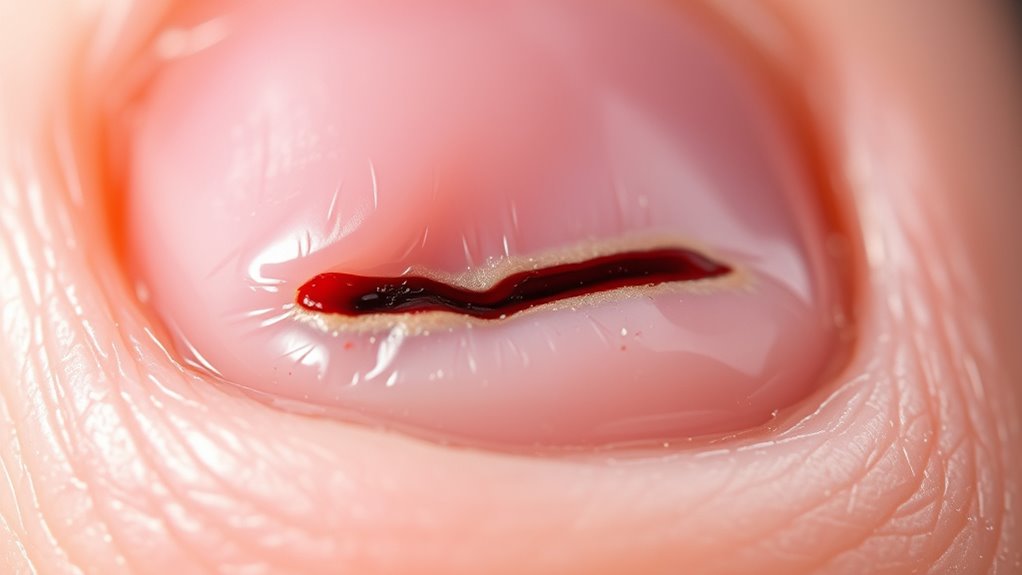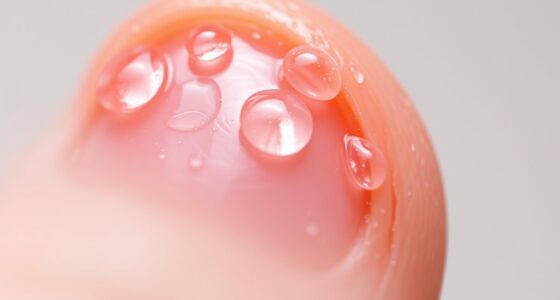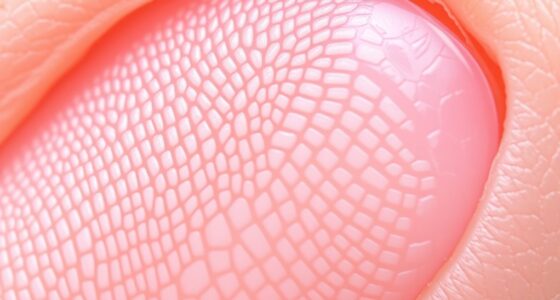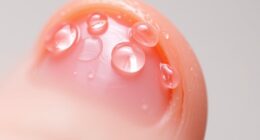When your nail sustains trauma, your body begins a healing process involving inflammation, tissue regeneration, and cell growth in the nail matrix. Protecting the area, keeping it clean, and avoiding further injury help support recovery. Over time, new cells form, pushing the nail forward, while nutrients like protein, vitamins A and C, and zinc aid regeneration. The entire healing can take weeks to months—stay attentive, and you’ll discover how your nails restore strength and appearance.
Key Takeaways
- Nail healing begins with inflammation, which prevents infection and clears damaged tissue.
- The nail matrix produces new cells that push the nail outwards during regrowth.
- Proper care, including cleaning and protecting the area, supports healthy healing and prevents further damage.
- Nutrients like protein, vitamins A and C, and zinc aid tissue regeneration and improve nail quality.
- Complete regrowth can take several weeks to months, depending on injury severity and nail location.
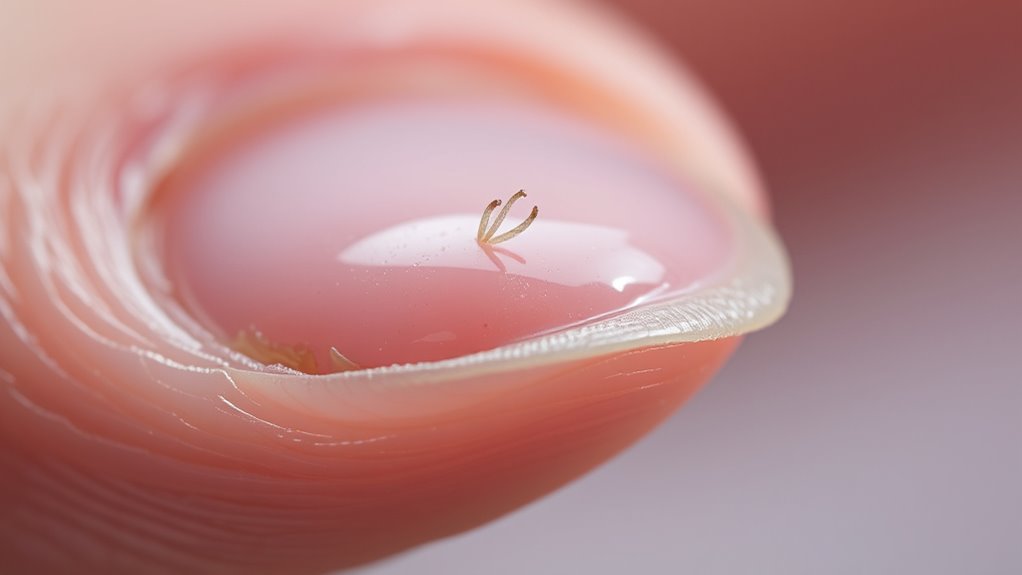
When your nails experience trauma, understanding the healing process can help you recover faster and prevent complications. The key to nail regrowth lies in the health of the nail matrix and the nail bed. The nail matrix, located beneath your cuticle at the base of your nail, is responsible for producing new nail cells. When trauma occurs, whether from a crush injury, cut, or biting, it can damage the matrix, disrupting the formation of new nail tissue. Similarly, the nail bed—the skin beneath your nail plate—supports and nourishes the growing nail and plays an essential role in the healing process. Damage to either area can delay regrowth or cause irregular nail formation.
If you experience trauma to your nail, it’s important to minimize further injury and keep the area clean. When the nail is partially torn or lifted, avoid pulling on it, as this can worsen the damage to the matrix or nail bed. Instead, gently clean the area with mild soap and water, and apply an antiseptic to prevent infection. Protecting the injured nail with a bandage can also help keep it clean and reduce trauma from daily activities. If bleeding occurs, apply gentle pressure until it stops, but avoid pressing too hard, which might cause additional damage.
The healing process begins with inflammation, where your body works to prevent infection and remove damaged tissue. During this stage, the blood supply to the area increases, and you might notice swelling or redness. The next step involves the regeneration of new tissue, where the nail matrix starts producing new nail cells. This process can take several weeks, depending on the severity of the injury. If the nail matrix sustains considerable damage, you might notice abnormal nail growth, such as ridges, discoloration, or deformities. In some cases, the nail may not regrow at all, especially if the matrix is severely damaged or destroyed.
During healing, your body relies on a good supply of nutrients like protein, vitamins A and C, and zinc to support tissue regeneration. Maintaining overall health and avoiding further trauma can substantially influence how quickly and smoothly your nail regrows. As new cells form in the matrix, they push the old nail outwards, gradually replacing it. The nail bed, meanwhile, acts as a foundation, filling in gaps and providing nourishment. With proper care, patience, and time, your nail can recover, although complete regeneration might take several months, especially for fingernails and longer for toenails. Being attentive to your injury and giving your nail the support it needs can make all the difference in ensuring a healthy recovery.
Frequently Asked Questions
Can Nail Trauma Cause Permanent Nail Loss?
Nail trauma can sometimes cause permanent nail loss, especially if the injury damages the nail matrix severely. If the trauma scars the nail matrix, it may impair nail regrowth or prevent new nails from forming altogether. However, minor injuries often heal well, allowing the nail to grow back normally over time. The outcome depends on the extent of damage and whether the trauma scars the nail-producing tissue.
How Can I Speed up Nail Healing Naturally?
To accelerate nail healing naturally, focus on natural remedies like keeping your nails clean and moisturized, and avoid further trauma. Guarantee you get adequate nutritional support by eating foods rich in biotin, zinc, and vitamins A, C, and E, which promote nail growth. You might also try applying coconut oil or aloe vera for added nourishment. These steps help your nails recover faster and strengthen over time.
Are There Treatments to Prevent Nail Deformities?
To prevent nail deformities, focus on proper nail care and trauma prevention. Keep your nails trimmed and moisturized to avoid brittleness, and wear protective gloves during activities that could cause injury. Avoid biting or picking at your nails, which increases deformity risk. Regularly cleaning and inspecting your nails helps detect issues early. Taking these steps minimizes trauma, supports healthy growth, and reduces the chance of permanent deformities.
What Signs Indicate an Infection in a Healing Nail?
Think of an infection in your healing nail like a storm brewing on a calm sea. Signs of infection include redness, swelling, increased pain, and warmth around the nail. Nail discoloration, such as yellow, green, or dark spots, also signals trouble. If you notice these signs, it is crucial to seek prompt treatment to prevent further damage and guarantee proper healing. Don’t ignore these warning signals; act quickly to protect your nail health.
Does Nail Trauma Affect Nail Growth in Both Hands and Feet?
Trauma impact can affect nail regeneration in both your hands and feet. When you experience nail trauma, it may temporarily slow or alter the growth process, but typically, your nails will regrow as long as the nail matrix isn’t severely damaged. Hands usually recover faster due to more frequent nail growth, but feet can take longer. Overall, trauma impact varies depending on severity, but healthy nail regeneration is common with proper care.
Conclusion
Think of your nail like a tiny garden, delicate yet resilient. When trauma strikes, it’s as if storms batter your plants, but with time, patience, and care, new shoots push through the soil, reclaiming their space. Your body’s natural healing is the gardener, nurturing each new growth until your nail is whole again. So, trust nature’s rhythm—your nail’s comeback is a beautiful, steady symphony of renewal.
